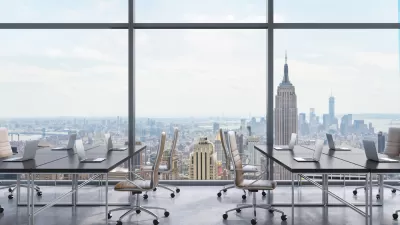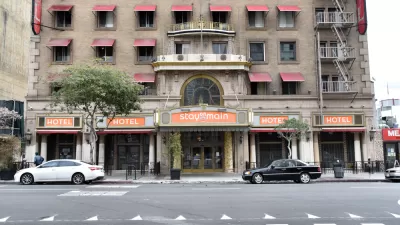Cities with ordinances aimed at making commercial-to-residential conversions easier are reaping the benefits.

The rise of commercial-to-residential conversions in Los Angeles reveals how easing permitting for adaptive reuse can yield positive results, writes Molly Bolan in Route Fifty. “Last year, the city accounted for 12% of the country’s adaptive reuse projects, creating more than 1,200 units, according to a recent report from Yardi Matrix, a commercial real estate research firm.”
Adaptive reuse isn’t new for the City of Angels, Bolan points out. “Los Angeles adopted its first adaptive reuse ordinance in 1999, making it easier for developers to convert underutilized commercial spaces into housing. The policy helped bring 12,000 residential units to the heart of the city.” In 2003, the city expanded the ordinance to include more neighborhoods outside of downtown, but large parts of the city still fall outside its purview, and only buildings built before 1975 are eligible.
Now, “City officials are looking to change that. A proposed update would expand the ordinance to cover the entire city, as well as reduce minimum unit size requirements and eliminate minimum parking requirements for projects within a half-mile of a major public transit stop.” The proposed update would apply to any building over 15 years old.
Bolan adds another example from a much smaller community: Kissimmee, Florida was home to 6 percent of the nation’s conversions last year, with hotels and motels accounting for a large part of this number. Because of the area’s tourist-commercial zoning rules, “developers don’t have to navigate a rezoning process and aren’t subject to public hearings.”
FULL STORY: How cutting red tape can encourage housing conversions

Manufactured Crisis: Losing the Nation’s Largest Source of Unsubsidized Affordable Housing
Manufactured housing communities have long been an affordable housing option for millions of people living in the U.S., but that affordability is disappearing rapidly. How did we get here?

Americans May Be Stuck — But Why?
Americans are moving a lot less than they once did, and that is a problem. While Yoni Applebaum, in his highly-publicized article Stuck, gets the reasons badly wrong, it's still important to ask: why are we moving so much less than before?

Using Old Oil and Gas Wells for Green Energy Storage
Penn State researchers have found that repurposing abandoned oil and gas wells for geothermal-assisted compressed-air energy storage can boost efficiency, reduce environmental risks, and support clean energy and job transitions.

Greening Oakland’s School Grounds
With help from community partners like the Trust for Public Land, Oakland Unified School District is turning barren, asphalt-covered schoolyards into vibrant, green spaces that support outdoor learning, play, and student well-being.

California Governor Suspends CEQA Reviews for Utilities in Fire Areas
Utility restoration efforts in areas affected by the January wildfires in Los Angeles will be exempt from environmental regulations to speed up the rebuilding of essential infrastructure.

Native American Communities Prepare to Lead on Environmental Stewardship
In the face of federal threats to public lands and conservation efforts, indigenous groups continue to model nature-centered conservation efforts.
Urban Design for Planners 1: Software Tools
This six-course series explores essential urban design concepts using open source software and equips planners with the tools they need to participate fully in the urban design process.
Planning for Universal Design
Learn the tools for implementing Universal Design in planning regulations.
Heyer Gruel & Associates PA
City of Moreno Valley
Institute for Housing and Urban Development Studies (IHS)
City of Grandview
Harvard GSD Executive Education
Salt Lake City
NYU Wagner Graduate School of Public Service
City of Cambridge, Maryland





























